
The flag of Iraq is the national flag of Iraq, includes the three equal horizontal red, white, and black stripes of the Arab Liberation flag, with the takbir written in green in the Kufic script in the centre.

The national flag of Saudi Arabia, also known as the al-Alam, is a green background with Arabic inscription and a sword in white. The inscription is the Islamic creed, or shahada: "There is no deity but God; Muhammad is the Messenger of God". The current design has been used by the government of Saudi Arabia since 15 March 1973.
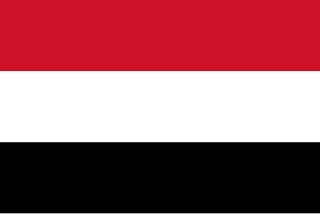
The flag of Yemen was adopted on May 22, 1990, the day that North Yemen and South Yemen were unified. The flag of Yemen is basically the Arab Liberation Flag of July 23, 1952, introduced after the Egyptian Revolution of 1952 in which Arab nationalism was a dominant theme. The Arab Liberation Flag of July 23, 1952 served as the derivation for the flags of both North and South Yemen prior to unification by omiting the distinctive elements from the existing designs, as well as for the current flags of Egypt, Iraq, Sudan, Palestine and Syria.
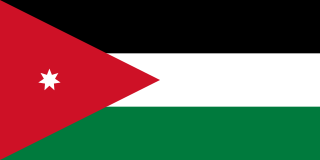
The flag of Jordan, officially adopted on 16 April 1928, is based on the 1916 flag of the Arab Revolt against the Ottoman Empire during World War I. The flag consists of horizontal black, white, and green bands that are connected by a red chevron. The colours are the Pan-Arab Colors, respectively representing the Abbasid, Umayyad, and Fatimid or Rashidun caliphates. The red chevron is for the Hashemite dynasty, and the Arab Revolt.
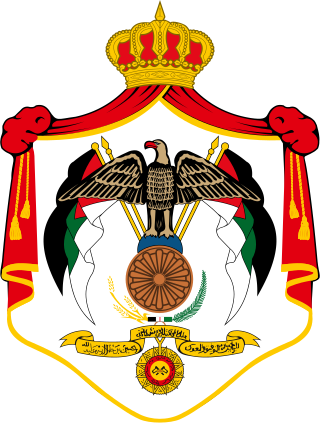
The coat of arms of Jordan or the emblem of the Hashemite Kingdom of Jordan is the arms of dominion for the king of Jordan. The emblem was initially adopted by Abdullah I, the emir of Transjordan, in 1921. The emblem continued to be used after Transjordan emerged as an independent kingdom in 1946.
As a result of the Syrian Civil War since 2011, there are at least two flags used to represent Syria, used by different factions in the war. The incumbent government of the Syrian Arab Republic led by the Ba'ath Party uses the red-white-black tricolour originally used by the United Arab Republic, while Syrian opposition factions such as the Syrian National Coalition use the green-white-black tricolour known as the ''Independence flag'', first used by Mandatory Syria.
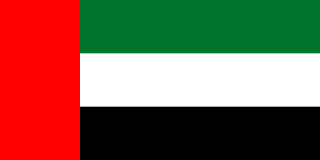
The flag of the United Arab Emirates contains the Pan-Arab colors red, green, white, and black. It was designed in 1971 by Abdullah Mohammed Al Maainah, who was 19 years old at that time, and was adopted on 2 December 1971 after winning a nationwide flag design contest. The main theme of the flag's four colors is the sovereignty and unity of the Arab states.
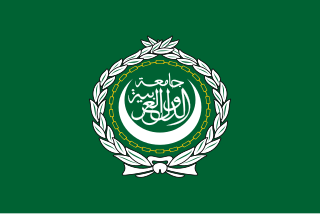
The flag of the Arab League comprises a green banner bearing the seal of the Arab League. The twenty-two links in the chain represent the twenty-two members of the League at the time of the flag's adoption. The script gives the name of the organization: "League of Arab States".
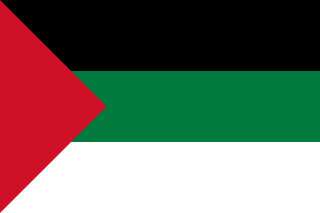
The pan-Arab colors are black, white, green and red. Individually, each of the four pan-Arab colors were intended to represent a certain aspect of the Arab people and their history.

Mansaf is a traditional Jordanian dish made of lamb cooked in a sauce of fermented dried yogurt and served with rice or bulgur.

The culture of Jordan is based on Arabic and Islamic elements. Jordan stands at the intersection of the three continents of the ancient world, lending it geographic and population diversity. Notable aspects of the culture include the traditional music and clothing of Jordan and interest in sports. These include football and basketball as well as other sports such as equestrianism, fencing, karate, swimming, and table tennis.

The Emblem of Iraq since the rule of Baathism features a golden black eagle looking towards the viewer's left dexter. The eagle is the Eagle of Saladin associated with 20th-century pan-Arabism, bearing a shield of the Iraqi flag, and holding a scroll below with the Arabic words جمهورية العراق.

Since 2011, Libya currently does not have an official national emblem. The Constitutional Declaration issued by the National Transitional Council on August 2011 defines the flag of Libya, but does not make any provisions for a coat of arms.
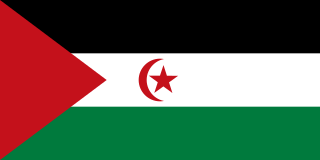
The flag of Western Sahara, also known as the flag of the Sahrawi Arab Democratic Republic, uses a national flag consisting of a black, white and green horizontal tricolor charged with a red star and crescent in the center stripe and a red chevron at the hoist. It is used on SADR-controlled areas, while the Moroccan flag is used on the occupied parts of Western Sahara.

An Islamic flag is the flag either representing an Islamic Caliphate, religious order, state, civil society, military force or other entity associated with Islam. Islamic flags have a distinct history due to the Islamic prescription on aniconism, making particular colours, inscriptions or symbols such as crescent-and-star popular choices. Since the time of the Islamic prophet Muhammad, flags with certain colours were associated with Islam according to the traditions. Since then, historical Caliphates, modern nation states, certain denominations as well as religious movements have adopted flags to symbolize their Islamic identity. Some secular states and ethnic or national movements also use symbols of Islamic origin as markers of heritage and identity.

The national emblem of Qatar is one of the official symbols of the state of Qatar. The emblem was initially adopted six years after the termination of the British protectorate, with the gained independence as a country under Sheikh Ahmad bin Ali Al Thani, and was designed under the reign the Emir of Qatar Khalifa bin Hamad Al Thani in 1976.

The flag of the Arab Revolt, also known as the flag of Hejaz, was a flag used by Hussein bin Ali and his allies, the Arab nationalists, during the Arab Revolt against the Ottoman Empire during World War I, and as the first flag of the Kingdom of Hejaz. It was designed by Mark Sykes but is highly reminiscent of previous Arab flags, such as the flags of the al-Muntada al-Adabi, al-ʽAhd and al-Fatat.
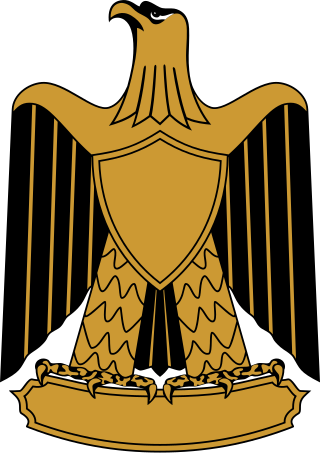
The Eagle of Saladin, known in Egypt as the Egyptian Eagle, and the Republican Eagle, is a heraldic eagle that serves as the coat of arms of many countries; Egypt, Iraq, Palestine, and Yemen. Since the 1952 Egyptian revolution, the eagle has been an iconic symbol of Egypt, and of Arab nationalism, particularly in Arab states that underwent anti-imperialist political change from the 1950s onwards. It was formerly the national symbol of the now defunct United Arab Republic, North Yemen, South Yemen, and the Libyan Arab Republic.

The Jordanian Armed Forces Band is the main musical unit of the Royal Jordanian Army made up of musicians who perform in official settings usually in the presence of the Jordanian royal family. When performing, all band members wear red and white checked Keffiyehs alongside their full dress uniform. The band was established in 1921, with a core of 10 musicians who served with the Arab Army. In 1929, bagpipes from the area that is now Egypt and Syria were first introduced to the band. In 1982, Hussein of Jordan approved the use of the band for purely ceremonial purposes. Today, the full band is composed of over 500 musicians who are arranged in a similar fashion to the Bands of the Household Division.






















